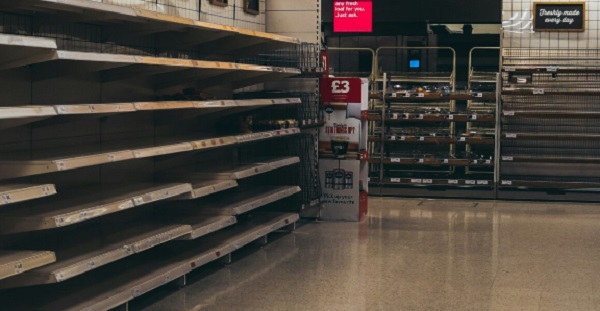Economy
Biden Is Failing The World


You can see that in Poland people are actually burning trash to stay warm. Burning trash in your fireplace creates toxic smoke. It’s hazardous. The government’s considering handing out masks so people can breathe more safely when they’re outdoors.
Recall that natural gas is the reason the United States reduced its carbon emissions more than any other country in the world. Carbon emissions have been on the decline globally, in large measure, because of the transition from coal to gas. Natural gas is something that most reasonable people agree is a superior fuel to coal. Natural gas is the reason the United States reduced its emissions by 22% between 2005 and 2020, which is five percentage points more than the United States had agreed to reduce our emissions under cap and trade legislation, which nearly passed Congress in 2010 and under the UN Paris Climate Agreement.

The above is a graph that was produced by Matthew Yglesias, a well-known progressive blogger. He tweets it out whenever somebody points out that President Biden isn’t doing all he can to expand oil and gas production. It’s accurate. It does show that oil production increased on a daily average under Biden from under Trump. But it’s deeply misleading. You have to remember that under Trump, the Coronavirus pandemic, for several months, massively slashed oil production.
You can see from the below chart of the EIA data on crude oil production that we still haven’t gotten back to where we were before the pandemic. Now consider how the need is much greater for US oil now that Europe and the United States are rejecting Russian oil.Upgrade

The United States is the biggest liquified natural gas exporter, it’s true. But it takes five years to bring online new LNG capacity in the United States. So all of the new LNG that’s come online during Biden’s presidency was due to past presidents.
And Biden has leased less land than any President since World War II. It’s a shockingly small amount of land: 130,000 acres as opposed to seven million acres under Obama, four million acres under Trump, during the first 19 months of their administrations. It’s a huge reduction in the amount of land being leased.
You can see that in some particular cases, like a very large oil and gas sale in Alaska, the Department of Interior claimed there wasn’t any industry interest in the lease. This turned out not to be the case. The Senator from Alaska, Lisa Markowski said, “I can say with full certainty based on conversations as recently as last night, that Alaska’s industry does have an interest in lease sales and the Cook Inlet to claim otherwise is simply false, not to mention stunningly shortsighted.”

People point out the oil and gas industry does have many thousands of leases, and that’s true, but there’s a high degree of uncertainty about whether the leases they have will produce oil and gas at levels that make sense economically to produce from.
So increasing oil and gas leasing at a time of an energy crisis in Europe seems like a no-brainer, but the Biden administration is not doing that. In fact, it’s been preventing the expansion of gas in many other ways.
You can see the Biden administration denied a request to have a formaldehyde regulation exempted. All else being equal, you’d wanna reduce that pollution. But I think a little bit of formaldehyde is gonna be a less toxic airborne event than having people breathing toxic wood and plastic smoke in Europe. The right thing to do, in terms of aiding our allies, would be to wave that regulation. But the Biden administration refused.

You can see that the Biden administration is actively considering forgoing all new offshore drilling in the Atlantic and Pacific. It may do no offshore leases at all for oil and gas.
Instead, the Biden administration has sought to give sanctions relief to Venezuela in the hopes that Venezuela would produce more oil. And of course, most famously Biden went to Saudi Arabia to ask the Saudis to produce more oil in July. Now, everybody agrees that was a huge foreign policy failure. The Saudis announced they would be cutting production with the rest of OPEC+. The Biden administration’s pressure on the Saudis apparently annoyed them. Now, they’ve been pushed closer into the arms of Russia. This is a pretty significant setback for the Biden administration.
At the same time Biden was going to Venezuela and Saudi Arabia to produce more oil. Biden administration was refusing to even meet with oil and gas executives. That’s a pretty serious snub when you consider that it’s an industry you want to expand production.
An oil and gas analyst on Twitter criticized a Senator from Wisconsin for suggesting the Democrats are responsible for the lack of refining capacity. He said, “What — do you also blame a political party for a flat tire?”
I pointed out that a single oil refinery outage would have little impact if we had sufficient refinery capacity, and the reason we don’t is that politicians, mostly Democrats have used regulations to prevent their construction. When I interviewed executives one said to me, “If you were an oil company, why would you invest hundreds of millions of dollars into expanding refining capacity if you thought the federal government would shut you down in the next few years? The narrative coming out of this administration is absolutely insane.”

So you can see here that refinery capacity was increasing all the way through 2020. It then declined due to the pandemic. And it has not risen since then. When the analyst was asked, why don’t we get more refineries? He clearly didn’t know. Or at least he said he didn’t know. But it’s clear the Biden administration has not wanted more refineries.
There was a chance to retrofit a major refinery in the US Virgin Islands. It was a refinery that was older. It needed pretty significant upgrades. It was polluting. But these are machines that can be fixed. Several billion dollars of investment would’ve fixed it and it goes back many years. This is an article from 2008. It describes how, at that time, the Democrats in the Senate killed a proposal for refinery expansion.
Go back to 2006. The same thing happened. The House was in the hands of the Republicans who passed a piece of legislation to expand refineries. And it was the Democrats who killed it. And, incidentally, they’re using the exact same arguments today that they used back then.
More recently, we’ve seen an attack on expanded natural gas pipeline capacity, including from Pennsylvania to the Northeast, particularly to Boston. The result of not having pipeline capacity is that they’ve been burning more oil for electricity in New England. In fact, oil-fired power jumped to a four-year high earlier this year. And they’ve been having to import liquified natural gas to New England rather than just pipe it in, which is significantly cheaper. Probably half as expensive.

Grassroots advocacy and lawsuits have prevented pipelines from being built. You can see there’s a strong correlation between the price of natural gas and the ability to get pipelines built. We stop building pipelines and gas gets more expensive. Globally, the impact is that we’re gonna return to coal. This is the consequence of stifling oil and gas production.
One could argue that we just need more scarcity in order to accelerate the transition to electric cars. But it’s notable that the major figures in this, including President Biden, supporters of President Biden, and representatives of his administration aren’t defending a pro-scarcity position. They’re instead claiming that they’re doing all they can to bring down oil and gas prices and expand production.
I think this data, and the historical chronology, paint a picture that shows that there has, in fact, been a war on natural gas and oil United States and that it is impacting global supplies, and leaving Europe vulnerable.
Click to see the video presentation of this article. Additional slides and graphs are in the video.
Business
Socialism vs. Capitalism

People criticize capitalism. A recent Axios-Generation poll says, “College students prefer socialism to capitalism.”
Why?
Because they believe absurd myths. Like the claim that the Soviet Union “wasn’t real socialism.”
Socialism guru Noam Chomsky tells students that. He says the Soviet Union “was about as remote from socialism as you could imagine.”
Give me a break.
The Soviets made private business illegal.
If that’s not socialism, I’m not sure what is.
“Socialism means abolishing private property and … replacing it with some form of collective ownership,” explains economist Ben Powell. “The Soviet Union had an abundance of that.”
Socialism always fails. Look at Venezuela, the richest country in Latin America about 40 years ago. Now people there face food shortages, poverty, misery and election outcomes the regime ignores.
But Al Jazeera claims Venezuela’s failure has “little to do with socialism, and a lot to do with poor governance … economic policies have failed to adjust to reality.”
“That’s the nature of socialism!” exclaims Powell. “Economic policies fail to adjust to reality. Economic reality evolves every day. Millions of decentralized entrepreneurs and consumers make fine tuning adjustments.”
Political leaders can’t keep up with that.
Still, pundits and politicians tell people, socialism does work — in Scandinavia.
“Mad Money’s Jim Cramer calls Norway “as socialist as they come!”
This too is nonsense.
“Sweden isn’t socialist,” says Powell. “Volvo is a private company. Restaurants, hotels, they’re privately owned.”
Norway, Denmark and Sweden are all free market economies.
Denmark’s former prime minister was so annoyed with economically ignorant Americans like Bernie Sanders calling Scandanavia “socialist,” he came to America to tell Harvard students that his country “is far from a socialist planned economy. Denmark is a market economy.”
Powell says young people “hear the preaching of socialism, about equality, but they don’t look on what it actually delivers: poverty, starvation, early death.”
For thousands of years, the world had almost no wealth creation. Then, some countries tried capitalism. That changed everything.
“In the last 20 years, we’ve seen more humans escape extreme poverty than any other time in human history, and that’s because of markets,” says Powell.
Capitalism makes poor people richer.
Former Rep. Jamaal Bowman (D-N.Y.) calls capitalism “slavery by another name.”
Rep. Alexandria Ocasio-Cortez (D-N.Y.) claims, “No one ever makes a billion dollars. You take a billion dollars.”
That’s another myth.
People think there’s a fixed amount of money. So when someone gets rich, others lose.
But it’s not true. In a free market, the only way entrepreneurs can get rich is by creating new wealth.
Yes, Steve Jobs pocketed billions, but by creating Apple, he gave the rest of us even more. He invented technology that makes all of us better off.
“I hope that we get 100 new super billionaires,” says economist Dan Mitchell, “because that means 100 new people figured out ways to make the rest of our lives better off.”
Former Labor Secretary Robert Reich advocates the opposite: “Let’s abolish billionaires,” he says.
He misses the most important fact about capitalism: it’s voluntary.
“I’m not giving Jeff Bezos any money unless he’s selling me something that I value more than that money,” says Mitchell.
It’s why under capitalism, the poor and middle class get richer, too.
“The economic pie grows,” says Mitchell. “We are much richer than our grandparents.”
When the media say the “middle class is in decline,” they’re technically right, but they don’t understand why it’s shrinking.
“It’s shrinking because more and more people are moving into upper income quintiles,” says Mitchell. “The rich get richer in a capitalist society. But guess what? The rest of us get richer as well.”
I cover more myths about socialism and capitalism in my new video.
Business
Residents in economically free states reap the rewards

From the Fraser Institute
A report published by the Fraser Institute reaffirms just how much more economically free some states are compared with others. These are places where citizens are allowed to make more of their economic choices. Their taxes are lighter, and their regulatory burdens are easier. The benefits for workers, consumers and businesses have been clear for a long time.
There’s another group of states to watch: “movers” that have become much freer in recent decades. These are states that may not be the freest, but they have been cutting taxes and red tape enough to make a big difference.
How do they fare?
I recently explored this question using 22 years of data from the same Economic Freedom of North America index. The index uses 10 variables encompassing government spending, taxation and labour regulation to assess the degree of economic freedom in each of the 50 states.
Some states, such as New Hampshire, have long topped the list. It’s been in the top five for three decades. With little room to grow, the Granite State’s level of economic freedom hasn’t budged much lately. Others, such as Alaska, have significantly improved economic freedom over the last two decades. Because it started so low, it remains relatively unfree at 43rd out of 50.
Three states—North Carolina, North Dakota and Idaho—have managed to markedly increase and rank highly on economic freedom.
In 2000, North Carolina was the 19th most economically free state in the union. Though its labour market was relatively unhindered by the state’s government, its top marginal income tax rate was America’s ninth-highest, and it spent more money than most states.
From 2013 to 2022, North Carolina reduced its top marginal income tax rate from 7.75 per cent to 4.99 per cent, reduced government employment and allowed the minimum wage to fall relative to per-capita income. By 2022, it had the second-freest labour market in the country and was ninth in overall economic freedom.
North Dakota took a similar path, reducing its 5.54 per cent top income tax rate to 2.9 per cent, scaling back government employment, and lowering its minimum wage to better reflect local incomes. It went from the 27th most economically free state in the union in 2000 to the 10th freest by 2022.
Idaho saw the most significant improvement. The Gem State has steadily improved spending, taxing and labour market freedom, allowing it to rise from the 28th most economically free state in 2000 to the eighth freest in 2022.
We can contrast these three states with a group that has achieved equal and opposite distinction: California, Delaware, New Jersey and Maryland have managed to decrease economic freedom and end up among the least free overall.
What was the result?
The economies of the three liberating states have enjoyed almost twice as much economic growth. Controlling for inflation, North Carolina, North Dakota and Idaho grew an average of 41 per cent since 2010. The four repressors grew by just 24 per cent.
Among liberators, statewide personal income grew 47 per cent from 2010 to 2022. Among repressors, it grew just 26 per cent.
In fact, when it comes to income growth per person, increases in economic freedom seem to matter even more than a state’s overall, long-term level of freedom. Meanwhile, when it comes to population growth, placing highly over longer periods of time matters more.
The liberators are not unique. There’s now a large body of international evidence documenting the freedom-prosperity connection. At the state level, high and growing levels of economic freedom go hand-in-hand with higher levels of income, entrepreneurship, in-migration and income mobility. In economically free states, incomes tend to grow faster at the top and bottom of the income ladder.
These states suffer less poverty, homelessness and food insecurity and may even have marginally happier, more philanthropic and more tolerant populations.
In short, liberation works. Repression doesn’t.
-

 Haultain Research6 hours ago
Haultain Research6 hours agoSweden Fixed What Canada Won’t Even Name
-

 Business1 day ago
Business1 day ago“Magnitude cannot be overstated”: Minnesota aid scam may reach $9 billion
-

 Censorship Industrial Complex1 day ago
Censorship Industrial Complex1 day agoUS Under Secretary of State Slams UK and EU Over Online Speech Regulation, Announces Release of Files on Past Censorship Efforts
-

 Business1 day ago
Business1 day agoLargest fraud in US history? Independent Journalist visits numerous daycare centres with no children, revealing massive scam
-

 Daily Caller2 days ago
Daily Caller2 days agoIs Ukraine Peace Deal Doomed Before Zelenskyy And Trump Even Meet At Mar-A-Lago?
-

 Business6 hours ago
Business6 hours agoWhat Do Loyalty Rewards Programs Cost Us?










